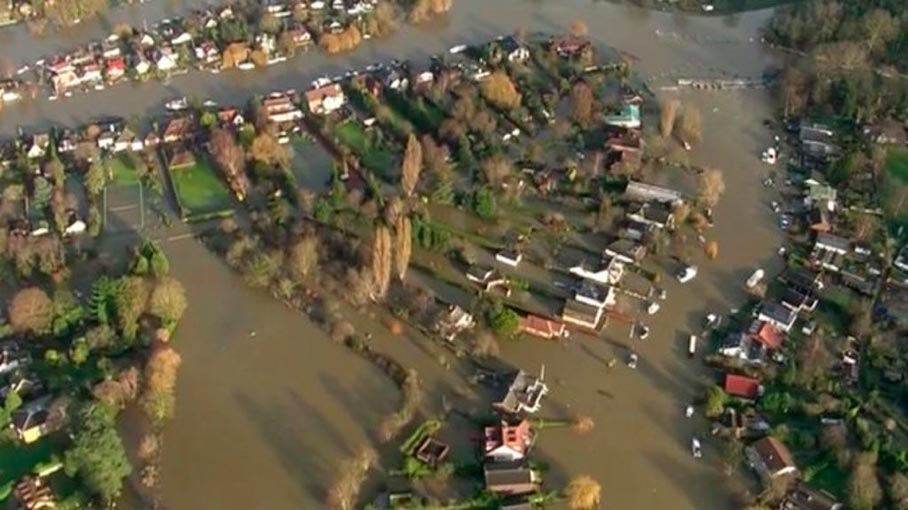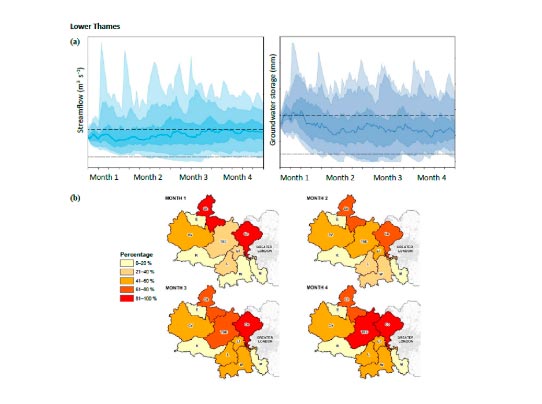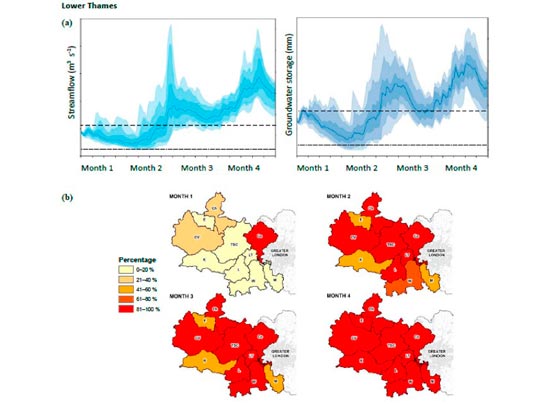
Aerial footage of the 2014 flooding on the Thames (source: BBC - https://www.bbc.co.uk/news/av/uk-25679668/uk-floods-environment-agency-warns-of-further-flooding).
Local stakeholders in the West Thames catchment: flood and drought forecasters, water resource managers, and groundwater hydrologists
Streamflow and groundwater level forecasts for the next 4 months, i.e. seasonal hydrological forecasts (SHFs)
Better water management in terms of
Two types of data were provided:
EFAS-Seasonal - Seasonal ensemble meteorological forecasts from ECMWF's System 4 are used as input to the LISFLOOD hydrological model. This is the set-up of the EFAS-Seasonal (European Flood Awareness System) operational system.
Improved EFAS-Seasonal – This has a similar set-up as the EFAS-seasonal data, except that the seasonal meteorological forecasts used as input to LISFLOOD were taken from a scientific experiment. These improved EFAS-Seasonal forecasts represented near “perfect” information as they were produced once the floods had happened and the weather conditions were known. While this cannot yet be achieved by operational systems, it does represent the theoretical upper level of forecast skill that may be available to water sector users in the future (for more information, see Neumann et al., 2018a).


Most West Thames local stakeholders present at the focus group reported using seasonal hydrological forecasts in their everyday job and believed that they could possibly forecast flood and drought risk. The stakeholders also indicated that the forecasts could be used to support decision-making and to increase preparedness. Still, many noted that the forecasts cannot yet be used in this way as the products that are available in the UK show too much uncertainty and have a coarse spatiotemporal resolution (i.e. Hydrological Outlook UK).
In December 2017, a focus group was held at the University of Reading in collaboration with the UK Environment Agency (EA; IMPREX stakeholders)1. It included a decision-making activity designed to capture how different water sector users currently interpret and act on SHFs to inform decisions in the West Thames. Participants were shown progressively confident and locally tailored SHF out to four months to focus on a period of extreme stormy weather and flooding (i and ii, Figures 1 and 2, respectively). To avoid participant bias through prior knowledge, they were not told which time period was covered by the SHFs.
Ensemble hydrographs for streamflow and groundwater levels indicated the predicted trajectory of the hydrological conditions for the next four months in each of the ten Thames catchments.2
Exceedance thresholds – the median and the 90th percentile of climatology – were provided for context. The maps showed the maximum probability that the full forecast ensemble for a catchment exceeded the 90th percentile of climatology in a given month.
Based on the EFAS-Seasonal forecasts (Fig. 1), the consensus was for above-average streamflow and groundwater levels, but participants requested clearer information to take action. Most participants opted simply to communicate internally and to keep an eye on the situation. Based on the improved EFAS-Seasonal forecasts (Fig. 2), the consensus was for confident forecasts that showed a high risk of streamflow and groundwater flooding in about 6 weeks' time. Participants also increased their decision/action choice in response to these more confident, locally tailored forecasts. They, for instance, adopted a “watch and wait” approach, requested further information about the situation (i.e. reliability of the forecasts), informed other organisations and implemented actions for preparedness.
Local knowledge, risk appetite, and experience of previous flood events played an important role in informing decisions. Discussions highlighted that forecast uncertainty does not necessarily pose a barrier to use, but that SHFs need to be presented at a finer spatial resolution than that of currently available operational products to aid local decision-making. The discussions also revealed that SHF information that is visualized using combinations of maps, text, hydrographs, and tables are more easily interpreted and that better communication of SHFs that are tailored to different user groups is needed.
Currently, the EA use SHFs predominantly as supporting information and rely on shorter-range forecasts for action. As a co-developer of this focus group, they expressed the ambition to make conscious decisions based on SHF as part of routine incident management strategies though. They suggested this could be achieved by helping staff to interpret this type of information and by identifying suitable low-consequence actions that could be taken.
Neumann, J. L., Arnal, L., Emerton, R., Griffith, H., Theofanidi, S., and Cloke, H.: Supporting the integration and application of seasonal hydrological forecasts in the West Thames, Technical Report for IMPREX, https://doi.org/10.13140/RG.2.2.19905.25447, 2017.
Neumann, J. L., Arnal, L. L. S., Magnusson, L., and Cloke, H. L.: The 2013/14 Thames basin floods: Do improved meteorological forecasts lead to more skilful hydrological forecasts at seasonal timescales?, J. Hydrometeorol., 19, 1059–1075, https://doi.org/10.1175/JHM-D-17-0182.1, 2018a.
Neumann, J. L., Arnal, L., Emerton, R. E., Griffith, H., Hyslop, S., Theofanidi, S., and Cloke, H. L.: Can seasonal hydrological forecasts inform local decisions and actions? A decision-making activity, Geosci. Commun., 1, 35-57, https://doi.org/10.5194/gc-1-35-2018, 2018b.
1. for more information, see Neumann et al., 2017; 2018b
2. here shown for the Lower Thames only; for full material, see Neumann et al., 2018b.

Four-month hydrological forecasts from EFAS-Seasonal. (a) Ensemble hydrographs for streamflow (light blue) and groundwater levels (dark blue) for the Lower Thames (LT) catchment. Exceedance thresholds (based on records from 1994 to 2014) are shown as Q10 (dashed line) and Q50 (dotted line). (b) Choropleth map shows the maximum probability that the full hydrograph ensemble for a catchment exceeds the Q10 streamflow threshold in a given month.

Same as above, but based on the “improved” EFAS-Seasonal forecast.